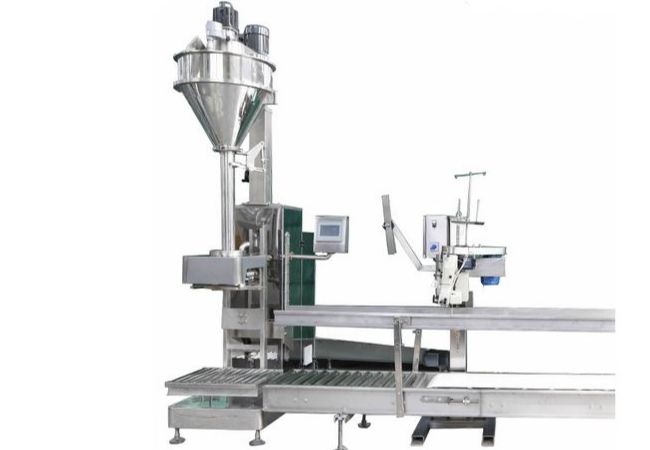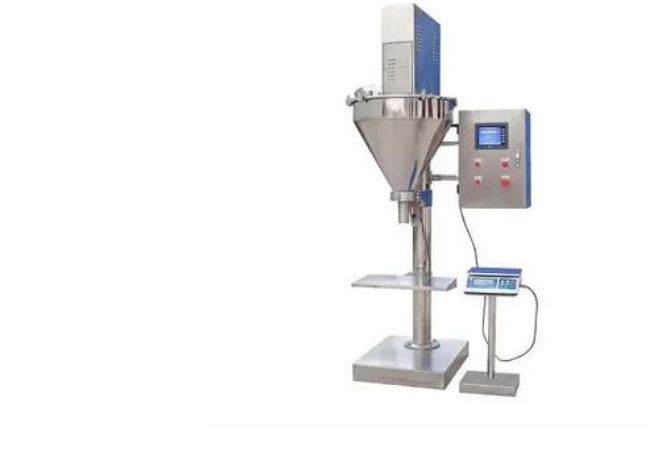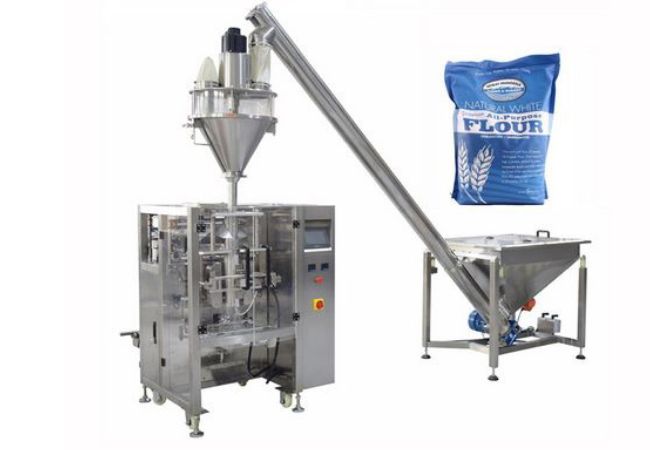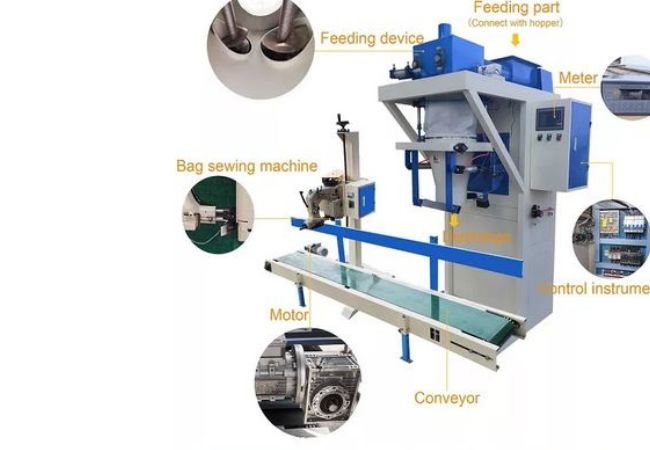Flour packing machine is an integral part of any commercial flour packaging line.
It is effective in packing flour in equal weights.
In this flour packing machine guide, we are going to discuss all the important details you should know to make informed purchase.
What is Flour Packaging Machine?

Flour Packing Machine
Flour packaging machines fill and seal desired amount of flour in packages with exceptional accuracy.
It provides the most perfect solution for packaging ground and fine products with high and medium density and fluidity.
The machine body features top-quality materials that guarantee long service life.
You can use this efficient commercial packaging equipment in either large, medium or small flour packing line.
Features of Flour Packaging Machine
Flour packaging machine enables dust-free and hygienic packaging of different types of flours.
Its ergonomic design minimizes operator movement and has a fast fill time with suitable access for maintenance.
Let’s look at the key properties of the best flour packaging machine.
- Adopt PLC control system that ensures simplified configuration by the operator.
- Touch screen control panel that enables you to monitor number of fill-in and filled flour packages.
- Automatic dosing system with excellent weight filling accuracy
- Strong body frame and contact parts made using food-grade stainless steel
- Has dust collection system
- Features automatic lubrication system
- Adjustable belt conveyor system with a driver controller that you can tune to the desired speed.
- Automatic safety protection and fault diagnosis, safety protection
- Fully synchronized machine operations, mechanical parts and sewing machine.
Types of Flour Packing Machine
The 2 main types of flour packing machines include:
1. Semi-Automatic Flour Packing Machine
These machines employ a blend of manual and automated PLC-based operations.
You need an operator to load the packaging bags and raw material into the equipment.
For this reason, there will always be variations in the speed of semi-automatic flour packer.
This is because it will rely on the speed of operator.

Semi-automatic Flour Packing Machine
Semi-automatic flour packaging machines are ideal if you are managing low-volume packing applications.
They offer a safe means of unitizing packages, whilst offering a perfect chance to meet the unique demands of your customers.
2. Fully Automatic Flour Packing Machine
These types of flour packing machine are fully automated and require minimal human intervention during packaging cycle.
Most advanced fully automatic flour packers employ PLC system that enables their operation from a central digital control panel.
The machines are perfect for higher volume flour packaging applications requiring exceptional precision.

Automatic Flour Packing Machine
Often, a conveyor belt feeds the packaging bags into the flour packing machine before it begins the packaging process.
Also, the equipment features sensors that ensure efficient and accurate operations.
Key Parts of Flour Packing Machine

Flour Packing Machine Parts
The main components of flour packaging machine include the following:
i. PLC Control System
Here is where there are all the programs necessary for operating the flour packing machine.
The control system has both the start and stop buttons.
Advanced packaging machine have touch screen user interface from where you can adjust the operating parameters of the equipment.
ii. Hopper
This is the large cone-shaped or pyramidal container that holds the flour that you want to package. Hoppers are made using food-grade stainless steel and are found at the apex of the machine.
You can choose between single and double hopper flour packaging machine.
iii. Dosing System
The dosing system is essential in automatic filling of the flour packages.
You can use the system as a standalone unit or integrate it within the flour packing machine.
Dosing system can fill your products by volume or weight.
iv. Load Cell
Digital or analogue load cells facilitate more accurate weight control, faster filling rates, and shorter machine stoppage periods.
Their design allows for integration into flour packing line under continuous operation.
They are not only accurate but also exceptionally reliable and robust, in order to achieve packaging efficiency.
v. Weighing Controller
Merged with load cells, weighing controllers design enables effortless integration with automatic systems.
They provide excellent weighing operation, digital filters for vibration elimination, and application performance optimized for flour packing machines.
The weighing controllers can manage applications for filling, weight control, loss-in-weight dosing, and continuous belt weighing.
Therefore, they cover all weighing requirements related to flour packing line.
vi. Fill Height Adjustment Mechanism
This part of flour packing machine helps the operator to adjust the fill height as desired.
It has a steel structure that also supports the packaging equipment.
vii. Conveyor system
The packaging conveyor is a mechanical handling equipment that offers streamlined means of moving packed flour through the factory.
It includes rollers, belts and other gadgets to move the packages from one point to another.
viii. Drive System
Here is where the flour packaging equipment produces the energy needed to drive the whole process.
It comprises of transmission and motors, which include electric, VFD, vacuum suction, and stepper motor.
However, the commonly used motor type is servo system.
ix. Package Sealing Mechanism
There are several sealing mechanisms you can use to close the flour packages.
The commonly used sealing techniques include heat sealing, gluing and sewing.
How Flour Packing Machine Works
After flour packing machine installation, you can use it to package different products based on the configurations.
Here is the step-by-step process of the working principle of flour packaging machine.
Step 1: Loading of Packaging Bags
The operator manually feeds the bags in an in-feed magazine within preset intervals.
This should be carried out carefully to ensure correct filling when you start the machine.
After loading the bags, feeder roller then transfers them into the equipment.
In automatic flour packing machines, a robotic arm uses vacuum to hold each bag and transfer it to grippers.
Step 2: Filling of the Packages
Flour falls from the hopper located on top of the dosing system.
After spouting a bag, the operator presses the start button to commence the filling cycle.
The dosing speed of flour packing machine might vary based on the fluidity and density of the product.
The system opens the conveying air valve to deliver low-pressure air to weighing hopper of dosing system.
This forces the flour out of the chamber, down the dosing spout into the bag.
The load cells and weighing controller regulates the amount of flour filled into the bag.
Step 3: Removing Filled Bag
After reaching the target weight, the weight controller compels a cut off valve or pinch to stop material flow and shuts the conveying air valve. A mechanical clamp then removes the filled bag from the dosing spout.
Step 4: Sealing the Flour Package
After bag filling, the conveyor system transfers them to the sealing system.
You can seal the bags by gluing, hot sealing or sewing machine.
Most flour packing machines use sewing machines.
These high-speed sewing systems automatically seal open mouth poly or paper bags.
Packaging Weight of Flour Packing Machine
The weighing range of flour packaging machine varies from 5-50 Kgs.
However, you can customize the value depending on your target customers.
Types of Dosing Systems Used In Flour Packing Machine
Flour packing machines can have different types of dosing systems based on the properties of the material you are bagging.
i. Gravimetric System
Also known as loss-in-weight feeder, gravimetric system describes a self-calibrating dosing mechanism.
It doses the products depending on weight, which the system measures utilizing a load cell.
Weight calculation is through loss-in-weight technology that determines the reduced weight during dosing process.
A stepper motor automatically adjusts the speed of self-calibrating gravimetric dosing system when it senses a change in material flow.
This avoids the necessity for manual correction that is common when employing a volumetric dosing mechanism.
Therefore, gravimetric feeder gives you total control over the quality of the end product.
Due to the self-calibrating system, there are no chances of overfilling that eventually helps in saving costs.
ii. Volumetric System
A volumetric feeder represents a dosing system that delivers a specific volume of material within a determined timeframe.
The dosing mechanism applies displacement principle to fill the flour packs.
Different from gravimetric fillers, you need to set the dosing speed of the volumetric filling system manually.
The speed may differ depending on nature of raw materials you are processing.
Volumetric filler is a better alternative if you are running a small flour packing line and looking to cut cost on dosing equipment.
Nevertheless, a gravimetric filling system enables you to save substantially on input material due to a more accurate feeding operation.
This implies that the system normally offers a higher ROI in the long run.
Flour Packing Machine Price
The price of flour packing machine ranges from $5,000 to $50,000.
This variation in cost depends on a number of factors which include:
Functionality
Your flour packing machine price will depend on its capabilities, considering variables like speed, production rate, and the level of automation.
Level of Automation
Manual designs will feature few moving components, internal computer-controlled servo motors, and additional complex parts.
But, PLC system allows you to program and automate the operation of automatic versions. Therefore, they will be costlier in comparison to the manual types.
Machine Brand
Entry-level flour packing machine will utilize less materials and pack less volume compared to high-end models that cost more.
Despite the high initial investment, you will cut cost with high-end automatic versions.
The high rate of production will save on packaging material cost as you will often get discounts from suppliers for bulk purchases.
As a result, the overall cost of operating the top-quality automatic models will be lesser in the long run.
Labor
You may spend lesser amount of money on manual flour packing machine.
However, you will have to hire more operators to manage the packaging process.
Because of this, buying fully automatic designs that run with minimal human intervention might help you cut cost considerably.
This depends on volume of flour you will be packaging.
Specifications of Flour Packing Machine to Consider during Purchase
Here are the important flour packing machine specifications that you should consider when placing an order.
- Power (KW)
- Voltage (V)
- Packaging Speed
- Automation Level
- Capacity
- Drive Type
- Compressor Pressure
- Construction Material
- Size
Applications of Flour Packaging Machine
Flour packing machine commonly find use in food processing industry for packaging different types of flour including:
- Maize flour
- Wheat Flour
- Cassava Flour
- Banana flour
- Potato Flour
- Sorghum Flour
- Soy Flour
- Coconut flour
Conclusion
At Jochamp, have a range of packaging machine for all your production needs.
Whether you want powder filling machine, granules filling machine, coffee filling machines or sugar packaging machines – we offer a wide range of packaging solutions.
More Resources:


